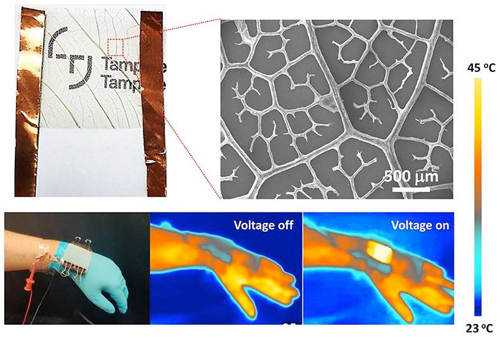| Oct 15, 2020 |
Researchers develop a plant-based thermotherapy patch
(Nanowerk News) A team of researchers at Tampere University has developed a biodegradable, transparent, flexible and fast-acting thermotherapy patch from plant leaves (npj Flex Electronics, "Flexible biodegradable transparent heaters based on fractal-like leaf skeletons").
|
|
The patch is compatible with flexible electronic applications. Plant material was used to reduce the amount of electronic waste.
|
|
The researchers used leaves from a Bodhi tree (Ficus religiosa). The veins of the leaves have a fractal pattern that makes the surface highly flexible and shearable. Silver nanowires were attached to the leaf skeleton, and the surface was encapsulated in a biodegradable transparent tape.
|
 |
| A biodegradable, transparent, flexible and fast-acting thermotherapy patch from plant leaves. The patch is compatible with flexible electronic applications. (Image: Tampere University) (click on image to enlarge)
|
|
The fractal-based design can also be used in flexible electronic applications, as it overcomes the limitations of conventional planar designs by maximizing the surface area at the microscale, or more specifically, maximizing the surface area to volume ratio via simple scaling. The large surface area enables effective heat transfer, allowing a rapid response time and preventing overheating. Due to the flexibile structure and uniform heating of the patch, it can also be attached to moving joints.
|
|
In orthopedics, medical thermotherapy pads are commonly used to reduce pain, improve blood circulation and decrease inflammation. They are also used in the treatment of arthritis, stiff joints, cervical spondylosis and physical injuries.
|
|
Traditional thermotherapy pads are known to have caused burns, mainly among people who fall asleep with their heating pads on or among the elderly who might not be very sensitive to heat. Part of the problem is that commercial heating pads are opaque, and users cannot see how their skin is reacting to the therapy.
|
|
As the thermotherapy patch is made entirely of plant-based materials, it can help reduce carbon footprints and electronic waste. All the materials used in the fabrication process are eco-friendly, economical, easily accessible and easy to fabricate.
|
|
“Electronc waste is a growing environmental problem worldwide. The use of biotic architectures and materials can help in the design of next-generation flexible electronic devices while also addressing e-waste problems,” says Vipul Sharma, postdoctoral researcher appointed by the Academy of Finland.
|
|
Sharma works in the Bioinspired Materials and Robotics group, which is part of the BioMediTech institute of the Faculty of Medicine and Health Technology at Tampere Univesity. The group is headed by Academy Research Fellow Veikko Sariola.
|
|
Electronics, especially flexible electronics, are increasingly integrated into medical devices, textiles, wellness trackers and other portable devices, among other things.
|
|
The concept can also be applied in various applications such as defogging/defrosting, wearable devices, industrial heat systems, sensors, thermochromic displays and microfluidic chips.
|

